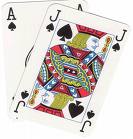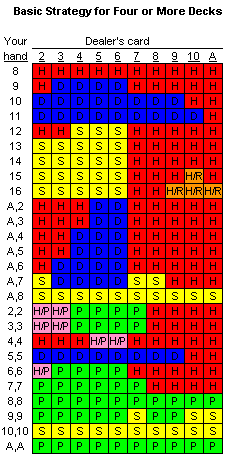 The Basic Strategy. The Basic Strategy.
The most important thing to know about blackjack is the basic strategy,
which can be found in every introductory blackjack book. This strategy is simply
the best way to play every possible situation, without any knowledge of the
distribution of the rest of the cards in the deck.
The chart below is for
blackjack played with four or more decks. There are a few differences for fewer
decks in very borderline situations. Unless you are very serious about cutting
down the edge as much as possible it is quite safe to use this basic strategy
for any number of decks.
To use the basic strategy look up your hand along the left vertical edge and
the dealer's up card along the top. In both cases an A stands for ace. From top
to bottom are the hard totals, soft totals, and splitable hands. The splitable
hands have been divided into two groups depending on whether or not doubling
after splitting is allowed. In multiple deck games doubling after a split is
usually allowed and that rule can go either way in single deck. In the body of
the chart are color coded cells that indicate the best play: H=hit, S=stand,
D=double, P=split, H/P=split if allowed to double after a split, otherwise hit,
H/R=surrender if allowed, otherwise hit.


Some other situations have been
left out to keep the chart as small as possible they are:
-
Always hit a hard 7 or less in single deck.
-
Always hit a hard 8 or less in multiple deck.
-
Always stand on a hard 17 or more.
-
Always stand on a soft 20 or more in single deck.
-
Always stand on a soft 19 or more in multiple deck.
-
If you have a soft total that normally calls for doubling, but the rules
do not permit you to do so, then hit on soft 17 or less and stand on soft 18
or more.
Surrender
Sometimes in a 6 or 8 deck game the player has the option to surrender.
To be specific the player may forfeit half their bet to be excused from playing
out their hand. Obviously this option should only be taken in the worst hands
when the net return is less than 50%. In late surrender (the only kind I have
ever seen) the player may only opt to surrender after the dealer checks for a
blackjack. The following table is a basic guide for when to surrender (Y=yes,
N=no).
|
Basic Surrender Strategy |
|
Player's
Hand |
Dealer's Card |
|
9 |
10 |
A |
|
15 |
N |
Y |
N |
|
16 |
Y |
Y |
Y |
House Edge
The table shows the house
edge assuming the player is using the basic strategy and the following
rules:
-
Dealer stands on a soft 17
-
Player may double after a split
-
Player may double on any two cards
-
Split up to 3 or 4 hands
-
Draw one card to split aces
-
No surrender
|
Blackjack Statistics
|
|
Number
of Decks
|
House
Edge
|
|
1
|
-0.15%
|
|
2
|
0.19%
|
|
4
|
0.35%
|
|
6
|
0.40%
|
|
8
|
0.43%
|
Rule variations will have an effect on the player's expected return. The
numbers below show the effect on the player's return under various rules and are
after taking into consideration proper basic strategy adjustments. These changes
are relative to the benchmark rules above.
|
Rule Variations |
|
Rule |
Effect |
|
Player may draw to split aces |
+.19% |
|
Player may re-split aces |
+.08% |
|
Late surrender |
+.09% |
|
Player may double on 9-11 only |
-.09% |
|
Player may double on 10,11 only |
-.18% |
|
Player may not double after splitting |
-.14% |
|
Player may not re-split |
-.10% |
|
Dealer hits on soft 17 |
-.22% |
|
No hole card: ace showing |
-.02% |
|
No hole card: ten showing |
-.10% |
|